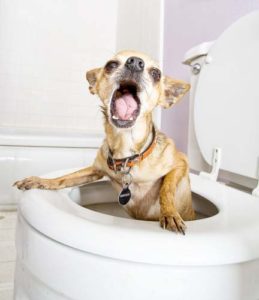Some dog owners choose to get an indoor dog toilet for their pets during the winter to spare them from going out into the cold. While this can be seen as a waste of money by some, others claim that it is not only a convenient thing, but even a necessity. So, is an indoor dog toilet for winter actually usefully and something you need to buy, or is it a waste of money?
What's an Indoor Dog Toilet?
There are a few different options when it comes to indoor dog toilets.
One of the more popular ones provides a section of real or artificial grass where dogs can go to do their business, like Petmaker Paw one. Others may not have grass but rather an imitation of ground and mud, and will have replaceable sheets, like the Bark Potty that we've reviewed before.
Another recent trend is a twist on the above type of indoor toilet for dogs, and is often called a “dog litter box” because the design is similar to cat litter boxes, as well as grated pet toilets, which is basically a tray fitted with a grate. Dog grass litter boxes are probably the least popular type because their design is still far from perfect.
Finally, and most typical variation of what can be called an “indoor dog toilet” are the famous potty training pee pads that are typically used to keep young pups from soiling everything around the house while going through housebreaking procedure. Dog pee pads are very popular, but I wouldn’t count them as doggy toilets, really.
While all these pet toilet options have their advantages and flaws, the real question is do you even need an indoor dog toilet for winter, and after your dog has already been housebroken. Let’s take a look at some of the factors you should consider before you make your decision.
SEE THIS: The 7 Best Pee Pad Holders, Trays and Litter Boxes
Do You Need an Indoor Dog Toilet?
 Whether you'll get any use out of an indoor toilet in winter depends on the kind of dog you have and how you plan on using the toilet. In most cases, it's unlikely an indoor doggy toilet is needed for winter, unless you have a dog that cannot spend 10 minutes outside in low temperature, or he's injured, recovering from surgery/disease, etc.
Whether you'll get any use out of an indoor toilet in winter depends on the kind of dog you have and how you plan on using the toilet. In most cases, it's unlikely an indoor doggy toilet is needed for winter, unless you have a dog that cannot spend 10 minutes outside in low temperature, or he's injured, recovering from surgery/disease, etc.
Your Dog’s Breed
Cold weather doesn’t have the same effect on all dogs. Some breeds are perfectly equipped for cold temperatures, like Alaskan Malamute, Siberian Husky, St. Bernard, Akita and many other long-haired breeds.
On the other hand, many short-haired and small breeds don’t do well in the cold and they might benefit from an indoor toilet so as to avoid going outside during really cold days. For example, Chihuahua, Greyhounds, Terriers, Whippet are all extremely sensitive to low winter temperatures and harsh weather.
Your Dog’s Age
Puppies and old dogs don’t stand the cold as well as adult dogs, so getting an indoor toilet in this case might be useful, but only in the case of extremely low temperature. If you just adopted a dog recently, then it may also be more difficult to potty train your puppy in cold weather than it is in normal weather conditions. However, you will have to invest more time and effort to train your puppy or senior dog to use the indoor toilet as well.
Your Dog’s Health
Healthy adult dogs should have no need for an indoor toilet in winter. On the other hand, if your pooch is suffering from some condition like incontinence, or severe cases of arthritis where low temperatures make it substantially worse, and similar health issues, an indoor toilet may be essential, even regardless of the weather conditions.
Dogs that suffer from serious case of arthritis can experience worsening of their symptoms as soon as temperatures drop and cold winter front hits your area. They typically have limited ability to walk in those conditions, so going to the toilet outdoors can cause them a lot of pain.
Some dogs can even have psychological problems that prevent them from going to the toilet outside. For example, some pets don’t like rain or snow and may refuse to do their business in those conditions.
Your Time
Many dog owners spend a lot of time away from home. If you work the standard 8 hours and you live alone in an apartment or a house without a doggy door, an indoor dog toilet can be a good solution to your problem. Remember that you'll need to toilet train your dog for this to work, and that's not an easy task. You must also not rely on an indoor toilet alone because dogs still require regular walks and physical exercise.
In conclusion, whether an indoor dog toilet for winter is a necessity or a waste of money will depend on your unique situation. In most cases, it's probably unnecessary and you can get by well without it. But if you feel that your dog will benefit from having an indoor dog toilet, whatever the reason may be, then it is certainly an investment worth making.
READ NEXT: Indoors vs Outdoors – Where Your Dog Belongs and Why














